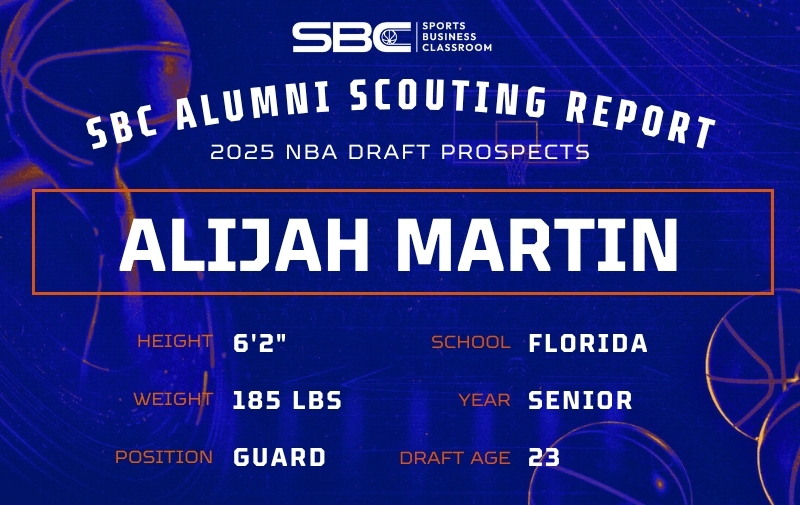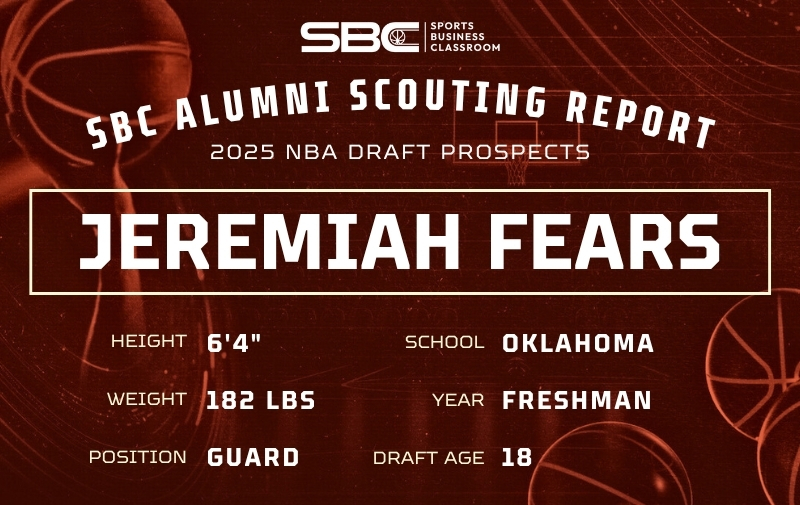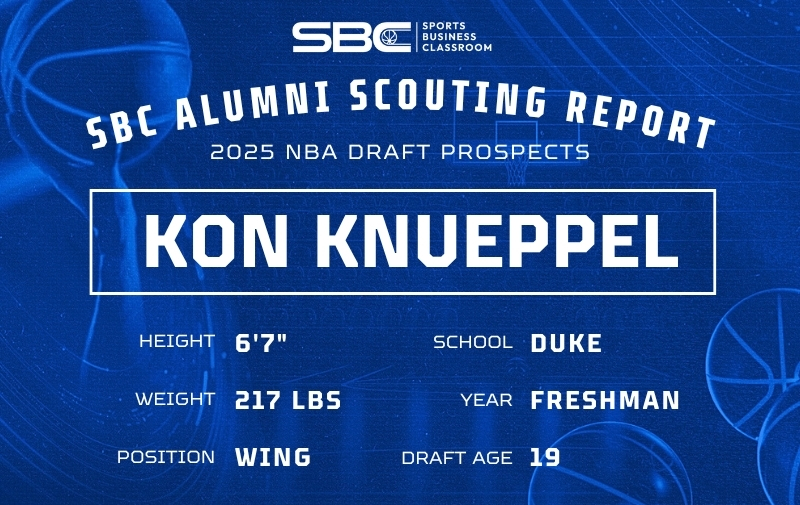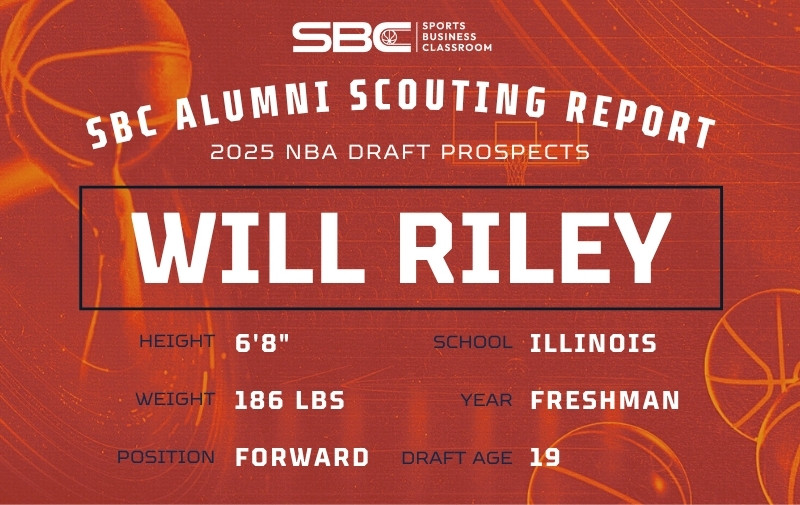
[The following scouting report is part of a series on potential 2025 draft prospects from Sports Business Classroom alumni.]
VJ Edgecombe
Frame: 6’5″, 180 lbs
Position: Guard
School: Baylor Bears
2024 Draft Age: 19
Stats via espn.com
Offense
Edgecombe is the 2024-25 Big 12 Freshman of the Year. Armed with effortless speed and fluid movement, he glides rather than runs up the court and explosively soars for rebounds, blocks, and electrifying dunks. Edgecombe combines excellent leaping ability with tremendous body control and agility to gain clear advantages on both sides of the ball. He’s a human highlight reel and next-level scorer; however, Edgecombe’s lack of offensive polish and assertiveness may keep him from being a consistent scorer at the next level on day one. His success in the NBA will depend on his defensive growth, spot-up shooting, and connective skills, which could buy him time to develop.
Edgecombe has relied chiefly on his athleticism as a driver, often out-jumping his competition, which worked in high school and some in college, but won’t be as effective against better, bigger, more disciplined defenses. Injuries robbed the Bears of needed practice time earlier in the season. The lack of structured opportunity may have contributed to Edgecombe seeming lost on occasion. Most of his shots came from the flow of the offense, as opposed to being targeted opportunities for him to get shots up. As the season progressed, there was a more consistent and focused effort to get him more structured opportunities.
Routinely playing off the ball showcased his potential as a confident floor spacer. Edgecombe averages 1.1 points per possession on catch and shoot opportunities, 60 percent contested, according to Matt Powers, via Synergy. His consistent shooting will create opportunities to attack closeouts, a skill that should be even more effective at the next level than in college’s tighter spacing. These will be easy opportunities to showcase his strengths as an explosive finisher off straight-line drives. He’s also a very eager and willing passer when he gets to the second level, frequently finding the weakside corner when penetrating.
His opportunities as a lead guard organizing the offense grew as the season progressed. While unselfishness is a strong trait for him, on and off the court, it sometimes translates to passivity in his offensive game. It can lead to long stretches where he neither shoots nor aggressively seeks to create, which might unfairly impact how people perceive his abilities.
Transition is where Edgecombe shines. He weaves gracefully through defenses with explosiveness off one leg or two. At Baylor, Edgecombe averaged 15.0 points, 5.6 rebounds, 3.2 assists, 2.1 steals, .6 blocks, 34 percent from three, and 50 percent from two. His teammates and coaches often discuss his floor game and overall effect on winning. Rather than simply trying to outlast defenders in the air, Edgecombe needs to be more refined in his drives and lean more into the finesse he has displayed on occasion. He doesn’t offer much deception either on the way up or while airborne, leading to inefficient finishes. According to Synergy, Edgecombe only finished on 43.2 percent of his drives.
Edgecombe doesn’t use on-ball screens as much as most guards would and hasn’t shown a strong ability to manipulate defenses while using those screens. He’s yet to consistently demonstrate patience reading the defense or utilize skills such as putting defenders in jail, snake dribble, floaters, or eye manipulation to move defenders the way a guard more practiced at screen usage would. In fairness, Edgecombe’s opportunities as an on-ball guard have been limited due to the guard-heavy roster at Butler. His ability to play effectively alongside more ball-dominant guards should be to his credit more than his detriment. As per Synergy, Edgecomb’s abilities as a primary scorer are further limited by his struggles as a pull-up jump shooter, shooting under 30 percent.
Edgecombe has another gear, and as he grows in confidence and experience, his game will be more reflective of his showing at the Olympic Qualifying Tournament for the Bahamas. Unlike most players his age, he played with the big boys in international competition, including Eric Gordon, Buddy Hield, and Deandre Ayton. He averaged 16.4 points, 5.5 rebounds, 3.8 assists, and 2.0 steals on 65.6 percent from the field and 38.5 percent from three. Edgecombe quickly impressed and became a featured player for the Bahamas.
Defense
Edgecombe’s defensive reputation comes more from his hustle, steals, and blocks than his actual on-ball defense. As a primary defender, he’s not consistently aggressive or physical, preferring a more conservative approach where he prioritizes high hands, giving ground to avoid fouls, and being in a good position for a mostly token contest. He could sit down in his stance more and prevent lower and more physical drivers from turning the corner on him as frequently. He struggles to stay attached to ball handlers when navigating screens as much as he needs to.
His agility and coordination allow him to track and intercept passes like an all-pro defensive back. He’s a hungry shot blocker, often tracking offensive players from the weak side to get blocks. Edgecombe will play the gaps and dig on penetrating guards. At his peak, Edgecombe can look like he’s playing a few seconds ahead of his opponents defensively—seeing passes before they’re thrown and setting offensive players up for steals and deflections. He is also an aggressive rebounder on both ends of the floor. Often high-pointing defensive rebounds and triggering transition by snatching and taking off up court. He must also be accounted for on the offensive boards, out-jumping or out-hustling most of the guards or forwards matched up with him. Edgecombe’s second jump is next level, frequently grabbing his own misses before defensive rebounders can flinch.
Edgecombe shows discipline defensively, often with early high-hands on contests, good communication, and hustling back defensively. He will get caught occasionally on the back door plays or ball watching. Still, the framework as a reliable defender is there; He strives to be solid, knows his and teammates’ assignments, and communicates constructively. Baylor plays a switching defense, and Edgecombe is often matched against bigger players, showing his physical defensive potential. He doesn’t shy away from the contact and will wrestle for position and fight to front the post. There’s an aggressive and physically intimidating defender in there waiting to be unleashed.
Edgecombe takes pride defensively and approaches the game cerebrally, which will serve him well in the NBA.
Looking Ahead
Edgecombe may not break out as quickly as his classmates projected to go early in this draft, but his floor as a player may impact winning sooner. He will not need the ball in his hands to be effective and can more seamlessly fit in with a team that may have a ball-dominant player or two. His experience at the Olympics will likely assist Edgecombe in making the quantum leap to the NBA, knowing now that Edgecombe can flourish in a pro setting. His commitment to defense and hustle will make it easier to stomach his mistakes as he refines his game offensively. His top-5 projected position may be advantageous because the team drafting him may not need him as a go-to guy on day one. His ceiling as a scorer will largely depend on the player development he receives and an increase in his overall assertiveness. The next gear for him is there with the tools, skills, athleticism, instincts, and work ethic to be a starter/rotation player for a competitive team, but more polish is needed if he’s going to reach his full potential.






